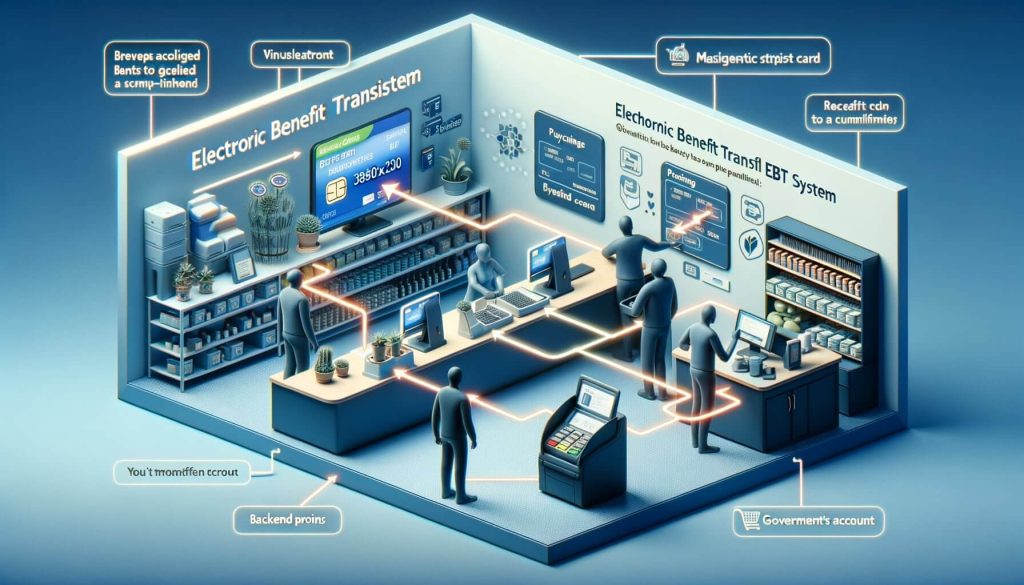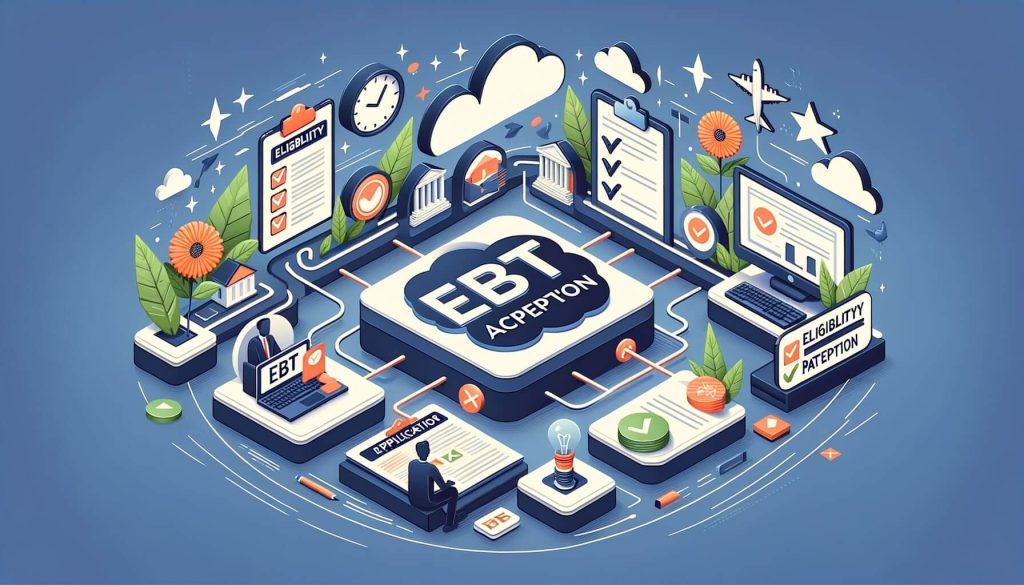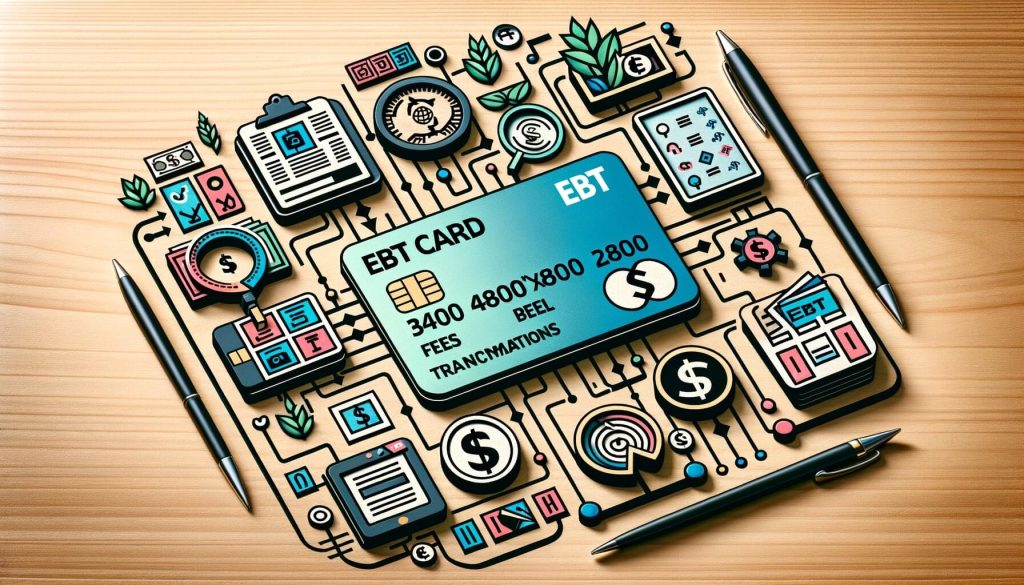
By Ethan Brooks February 9, 2025
Electronic Benefit Transfer (EBT) is a system that allows recipients of government assistance programs to access their benefits electronically. It has replaced the traditional paper-based method of distributing benefits, such as food stamps and cash assistance.
EBT provides a more efficient and secure way for individuals to receive and use their benefits, while also offering numerous advantages for small businesses that choose to accept EBT payments.
How Electronic Benefit Transfer (EBT) Works: A Step-by-Step Guide

1. Eligibility and Enrollment: Individuals who qualify for government assistance programs, such as the Supplemental Nutrition Assistance Program (SNAP) or Temporary Assistance for Needy Families (TANF), are issued an Electronic Benefit Transfer (EBT) card. This card functions like a debit card and is loaded with the recipient’s benefits each month.
2. Card Activation: Once the EBT card is received, the recipient must activate it by calling a toll-free number or visiting a designated website. This step ensures that the card is ready for use.
3. PIN Selection: The recipient is required to select a Personal Identification Number (PIN) to protect the security of their benefits. The PIN is entered at the point of sale to authorize transactions.
4. EBT Card Usage: Recipients can use their Electronic Benefit Transfer (EBT) cards at authorized retailers, including grocery stores, farmers markets, and other approved vendors. The card is swiped or inserted into a card reader, and the PIN is entered to complete the transaction.
5. Transaction Approval: Once the PIN is verified, the EBT system checks the recipient’s account balance to ensure there are sufficient funds to cover the purchase. If approved, the transaction is processed, and the recipient’s benefits are deducted accordingly.
Benefits of Accepting Electronic Benefit Transfer (EBT) for Small Businesses

1. Increased Customer Base: By accepting EBT payments, small businesses can attract a larger customer base, including individuals who rely on government assistance programs. This can lead to increased sales and revenue.
2. Community Support: Accepting Electronic Benefit Transfer (EBT) payments demonstrates a commitment to serving the community and supporting individuals in need. It can enhance the reputation of a small business and foster customer loyalty.
3. Streamlined Transactions: EBT payments are processed electronically, eliminating the need for manual calculations and reducing the risk of errors. This saves time and improves efficiency at the point of sale.
4. Guaranteed Payment: EBT transactions are authorized in real-time, ensuring that funds are available before the purchase is completed. This reduces the risk of bounced checks or insufficient funds.
5. Reduced Cash Handling: Accepting Electronic Benefit Transfer (EBT) payments reduces the need for cash transactions, minimizing the risk of theft and providing a safer environment for both customers and employees.
6. Access to Government Contracts: Small businesses that accept EBT payments may be eligible to participate in government programs and contracts, further expanding their opportunities for growth and success.
Eligibility and Application Process for EBT Acceptance

To accept Electronic Benefit Transfer (EBT) payments, small businesses must meet certain eligibility requirements and complete an application process. The specific criteria may vary depending on the state or program, but generally include the following steps:
1. Determine Eligibility: Small businesses must determine if they meet the eligibility criteria set by the state or federal government. This may include factors such as annual sales volume, type of business, and compliance with food safety regulations.
2. Obtain Necessary Licenses: Some states require businesses to hold specific licenses or permits to accept EBT payments. These may include a food service license or a retailer license.
3. Complete Application: Small businesses must complete an application form provided by the state agency responsible for administering the EBT program. The application typically requires information about the business, including its legal name, address, and tax identification number.
4. Provide Supporting Documents: Along with the application, businesses may need to submit supporting documents, such as proof of identity, proof of business ownership, and financial statements.
5. Attend Training: Some states require businesses to attend training sessions or workshops to ensure they understand the rules and regulations associated with accepting EBT payments.
6. Equipment and Technology Setup: Once approved, businesses must acquire the necessary equipment and technology to process Electronic Benefit Transfer (EBT) transactions. This may include a card reader, point-of-sale system, and software updates.
Understanding EBT Card Transactions and Fees

Electronic Benefit Transfer (EBT) transactions involve specific processes and fees that small businesses should be aware of. Understanding these aspects can help businesses effectively manage their EBT acceptance and avoid any unexpected costs.
1. Transaction Types: EBT cards can be used for two types of transactions: food purchases and cash withdrawals. Food purchases are authorized at authorized retailers, while cash withdrawals can be made at designated ATMs.
2. Transaction Limits: EBT cards have daily and monthly transaction limits, which vary depending on the program and the recipient’s benefit amount. Small businesses should be aware of these limits to ensure transactions are within the allowed thresholds.
3. Transaction Fees: Small businesses may be subject to transaction fees for processing EBT payments. These fees are typically charged by the payment processor or the state agency responsible for administering the Electronic Benefit Transfer (EBT) program. It is important for businesses to understand the fee structure and factor it into their pricing and financial planning.
4. Reimbursement Process: After accepting an Electronic Benefit Transfer (EBT) payment, small businesses must follow the reimbursement process to receive the funds. This typically involves submitting transaction records to the state agency for verification and reimbursement.
Electronic Benefit Transfer (EBT) Equipment and Technology Requirements for Small Businesses
To accept EBT payments, small businesses need to have the appropriate equipment and technology in place. This ensures smooth and secure transactions for both the business and the recipient.
1. Card Reader: Small businesses must have a card reader capable of processing Electronic Benefit Transfer (EBT) transactions. The card reader should be compatible with the EBT system and meet the security standards set by the state or federal government.
2. Point-of-Sale System: Integrating the Electronic Benefit Transfer (EBT) acceptance into the existing point-of-sale system streamlines the transaction process. The point-of-sale system should be able to handle EBT transactions and generate detailed reports for record-keeping purposes.
3. Software Updates: Small businesses must ensure that their software is up to date to support Electronic Benefit Transfer (EBT) acceptance. This includes installing any necessary updates or patches provided by the software provider or the state agency.
4. Training and Support: It is essential for small businesses to receive training on how to use the EBT equipment and technology effectively. This can be provided by the state agency or the payment processor, and may include on-site training or online resources.
EBT Reporting and Record-Keeping Obligations
Small businesses that accept EBT payments have reporting and record-keeping obligations to comply with the regulations set by the state or federal government. These obligations are in place to ensure transparency and accountability in the use of government benefits.
1. Transaction Records: Small businesses must maintain accurate and detailed transaction records for all Electronic Benefit Transfer (EBT) payments. This includes information such as the date, time, amount, and items purchased. These records should be kept for a specified period, typically three to five years.
2. Reporting Requirements: Small businesses may be required to submit periodic reports to the state agency responsible for administering the Electronic Benefit Transfer (EBT) program. These reports provide information on the number of EBT transactions, total sales volume, and any discrepancies or issues encountered.
3. Audits and Inspections: State agencies have the authority to conduct audits and inspections to ensure compliance with EBT regulations. Small businesses should be prepared to provide access to transaction records and cooperate with any inquiries or investigations.
EBT Fraud Prevention and Compliance Measures
To maintain the integrity of the Electronic Benefit Transfer (EBT) system, small businesses must implement fraud prevention and compliance measures. These measures help protect against fraudulent activities and ensure that EBT benefits are used appropriately.
1. Employee Training: Small businesses should provide training to their employees on how to identify and prevent EBT fraud. This includes recognizing counterfeit cards, verifying cardholder identification, and reporting any suspicious activities.
2. Compliance with Regulations: Small businesses must comply with the regulations and guidelines set by the state or federal government regarding Electronic Benefit Transfer (EBT) acceptance. This includes following transaction limits, reporting requirements, and maintaining accurate records.
3. Security Measures: Implementing security measures, such as surveillance cameras and secure storage for EBT equipment, can help deter fraudulent activities and protect sensitive information.
4. Reporting Fraud: Small businesses should have a process in place for reporting suspected EBT fraud. This may involve contacting the state agency responsible for administering the Electronic Benefit Transfer (EBT) program or the local law enforcement authorities.
Frequently Asked Questions (FAQs)
Q1. Can any small business accept Electronic Benefit Transfer (EBT) payments?
A1. Not all small businesses are eligible to accept Electronic Benefit Transfer (EBT) payments. Businesses must meet certain criteria and complete an application process to be approved for EBT acceptance.
Q2. Are there any fees associated with accepting EBT payments?
A2. Yes, small businesses may be subject to transaction fees for processing EBT payments. These fees vary depending on the payment processor or the state agency responsible for administering the EBT program.
Q3. How long does it take to receive reimbursement for EBT transactions?
A3. The reimbursement process for EBT transactions can vary depending on the state or program. Generally, small businesses can expect to receive reimbursement within a few business days.
Q4. What happens if a customer’s EBT card is declined?
A4. If a customer’s EBT card is declined, it may be due to insufficient funds or a technical issue. Small businesses should advise the customer to contact the Electronic Benefit Transfer (EBT) customer service for assistance.
Q5. Can small businesses accept Electronic Benefit Transfer (EBT) payments online?
A5. Currently, EBT payments can only be accepted in-person at authorized retailers. Online Electronic Benefit Transfer (EBT) acceptance is not yet widely available.
Conclusion
Understanding Electronic Benefit Transfer (EBT) is crucial for small businesses looking to expand their customer base and support their communities. By accepting EBT payments, businesses can tap into a larger market and benefit from streamlined transactions, guaranteed payment, and reduced cash handling.
However, it is important for businesses to meet the eligibility requirements, complete the application process, and comply with the regulations and obligations associated with EBT acceptance. By doing so, small businesses can not only enhance their financial success but also contribute to the well-being of individuals who rely on government assistance programs.